In the expansive domain of currency markets, the art of forex trading hinges profoundly on the adept utilization of fundamental analysis. This analytical approach delves deep into the intricate interplay between economic indicators, geopolitical events, and central bank policies, unraveling the complex web of factors that underpin currency price movements. Economic indicators, ranging from employment figures to consumer spending data, serve as critical barometers of a nation’s economic health, exerting a significant influence on investor sentiment and, consequently, on forex trading strategies. Similarly, geopolitical events, whether they are geopolitical tensions, trade negotiations, or geopolitical crises, inject volatility and unpredictability into forex markets, compelling traders to navigate shifting currents with strategic acumen.
Within the realm of forex trading, central bank policies wield unparalleled influence over currency valuations, making them a focal point of analysis for astute traders. Central banks’ decisions on interest rates, quantitative easing measures, and forward guidance reverberate across forex markets, shaping investor expectations and market sentiment. By scrutinizing central bank statements, economic forecasts, and policy announcements, forex traders gain valuable insights into potential shifts in monetary policy stances, enabling them to position themselves advantageously in anticipation of currency price movements. Thus, central bank policies emerge as a cornerstone of fundamental analysis in forex trading, guiding traders in their quest to decipher and capitalize on market trends.
As we delve deeper into the intricacies of fundamental analysis in forex trading, it becomes evident that this analytical approach serves as a compass amid the turbulent seas of currency markets. By integrating economic indicators, geopolitical events, and central bank policies into their trading strategies, forex traders can gain a holistic understanding of the forces driving currency price fluctuations. Armed with this knowledge, traders can make informed decisions, identify opportune moments for entry and exit, and navigate the dynamic landscape of forex trading with confidence and precision.
Table of Contents
1. Understanding Economic Indicators

Economic indicators stand as the pillars of insight into the health and direction of a nation’s economy, serving as indispensable tools for forex traders seeking to decipher currency price movements. These indicators encompass a diverse array of metrics, including gross domestic product (GDP) growth, inflation rates, unemployment figures, and consumer spending data. For forex traders, understanding economic indicators is paramount as they provide critical clues about the underlying economic fundamentals driving currency valuations. By analyzing the release of these indicators and comparing them against market expectations, traders can gauge the relative strength or weakness of a currency, thus informing their forex trading decisions with precision and foresight.
GDP growth serves as a primary gauge of a country’s economic performance, reflecting the overall expansion or contraction of its economy over a specific period. In forex trading, robust GDP growth typically translates to heightened investor confidence and increased demand for the currency of the respective country. Conversely, sluggish GDP growth or economic contraction may prompt investors to divest from the currency, leading to depreciation. Thus, forex traders closely monitor GDP reports and factor them into their trading strategies to capitalize on potential currency movements driven by shifts in economic growth dynamics.
Inflation rates represent another pivotal economic indicator that profoundly influences forex trading dynamics. Central banks often target specific inflation rates as part of their monetary policy objectives, aiming to maintain price stability and preserve purchasing power. When inflation rates exceed central bank targets, forex traders may anticipate interest rate hikes to curb inflation, thereby bolstering the currency’s value. Conversely, persistently low inflation or deflationary pressures may prompt central banks to implement accommodative monetary policies, such as interest rate cuts or quantitative easing, which can weigh on the currency’s exchange rate. As such, understanding the nuances of inflation data is essential for forex traders seeking to navigate the intricacies of currency markets with precision and efficacy.
2. The Impact of Geopolitical Events
Geopolitical events wield substantial influence over currency markets, serving as catalysts for volatility and uncertainty that can significantly impact forex trading dynamics. Events such as geopolitical tensions, trade disputes, elections, and geopolitical crises have the potential to disrupt market sentiment and alter currency valuations swiftly. For forex traders, staying attuned to geopolitical developments is essential as these events can trigger abrupt shifts in investor perceptions of risk, prompting swift changes in currency prices. By monitoring geopolitical events closely and assessing their potential implications for currency markets, traders can adapt their strategies accordingly to capitalize on emerging opportunities or mitigate risks effectively.
One prominent example of the impact of geopolitical events on forex trading is the volatility surrounding trade negotiations between major economies. Trade disputes, tariffs, and retaliatory measures can create uncertainty and market turbulence, leading to fluctuations in currency values as traders adjust their positions in response to shifting trade dynamics. Moreover, geopolitical tensions arising from geopolitical conflicts or diplomatic standoffs can amplify market volatility, driving investors to seek safe-haven currencies or adjust their exposure to higher-risk assets. As such, geopolitical events play a pivotal role in shaping market sentiment and influencing forex trading strategies in a dynamic and interconnected global landscape.
In addition to geopolitical tensions, geopolitical crises can also exert profound effects on currency prices, often leading to sharp movements driven by investor flight to safety or risk aversion. Events such as military conflicts, regime changes, or geopolitical upheavals can create heightened uncertainty and instability, prompting investors to seek refuge in perceived safe-haven currencies such as the US dollar, Swiss franc, or Japanese yen. Consequently, forex traders must remain vigilant to geopolitical developments and their potential ramifications on currency markets, incorporating geopolitical risk analysis into their trading strategies to navigate turbulent waters with resilience and adaptability.
3. Central Bank Policies and Their Effects
Central bank policies wield significant influence over currency prices in the forex market, making them a key focus of analysis for forex traders seeking to navigate market fluctuations with precision. Central banks utilize a variety of monetary policy tools, including interest rate adjustments, quantitative easing programs, and forward guidance, to achieve their economic objectives such as price stability, full employment, and economic growth. The decisions and statements of major central banks, such as the Federal Reserve, the European Central Bank, and the Bank of Japan, are closely scrutinized by forex traders for insights into future policy directions and their potential impact on currency valuations. By monitoring central bank policies and their effects on interest rates and money supply dynamics, forex traders can anticipate market reactions and adjust their trading strategies accordingly to capitalize on potential opportunities or mitigate risks.
Interest rate decisions represent one of the most impactful aspects of central bank policies on forex trading dynamics. Central banks adjust interest rates to influence borrowing costs, consumer spending, and investment decisions, which in turn affect economic growth and inflation. Higher interest rates tend to attract foreign capital inflows, driving up the value of the domestic currency, while lower interest rates may lead to capital outflows and currency depreciation. Consequently, forex traders closely monitor central bank meetings, statements, and economic projections for signals regarding future interest rate changes, as such announcements can trigger significant movements in currency prices and create trading opportunities.
Moreover, central banks employ forward guidance as a communication tool to manage market expectations and shape investor perceptions of future policy actions. Through speeches, press conferences, and policy statements, central bank officials provide guidance on the future path of interest rates and monetary policy stance. Forward guidance helps to reduce uncertainty and volatility in financial markets by providing clarity about central bank intentions and policy objectives. For forex traders, interpreting central bank forward guidance is crucial as it can provide valuable insights into the likely direction of currency prices and inform trading decisions in the ever-evolving landscape of forex trading.
4. Analyzing Economic Indicators for Forex Trading

Analyzing economic indicators is a fundamental aspect of forex trading, providing traders with valuable insights into the underlying economic conditions that drive currency price movements. Economic indicators encompass a wide range of metrics, including GDP growth, inflation rates, employment figures, and retail sales data, each offering unique perspectives on the health and trajectory of national economies. For forex traders, the ability to interpret and analyze these indicators is essential for making informed trading decisions and anticipating potential shifts in currency valuations. By closely monitoring economic releases and assessing their implications for market sentiment, traders can position themselves strategically to capitalize on opportunities or mitigate risks in the dynamic forex market.
Gross Domestic Product (GDP) growth serves as a key indicator of economic performance, reflecting the overall expansion or contraction of a country’s economy over a specific period. For forex traders, GDP data provides critical insights into the strength and resilience of a nation’s economy, influencing investor sentiment and currency valuations. Strong GDP growth typically correlates with increased demand for the country’s currency as investors perceive the economy as robust and attractive for investment. Conversely, weak GDP growth or economic contraction may lead to currency depreciation as investors seek alternative assets perceived as safer or offering higher returns.
Inflation rates represent another vital economic indicator that significantly impacts forex trading dynamics. Central banks often target specific inflation rates as part of their monetary policy objectives, aiming to maintain price stability and preserve purchasing power. For forex traders, inflation data provides valuable clues about potential shifts in central bank policy stances, as higher-than-expected inflation may prompt central banks to consider tightening monetary policy through interest rate hikes. Conversely, persistently low inflation or deflationary pressures may lead central banks to adopt accommodative policies, such as interest rate cuts or quantitative easing, which can influence currency valuations in the forex market.
Moreover, forex traders analyze employment figures, such as non-farm payrolls and unemployment rates, to gauge the health of labor markets and assess the broader economic outlook. Strong employment data signals a robust labor market and potential wage growth, which can stimulate consumer spending and economic activity, supporting currency appreciation. Conversely, rising unemployment or weak job growth may dampen consumer confidence and economic prospects, leading to currency depreciation as investors adjust their expectations and risk perceptions. By incorporating analysis of employment indicators into their trading strategies, forex traders gain valuable insights into underlying economic conditions and potential currency price movements.
5. Navigating Geopolitical Events in Forex Trading
Geopolitical events wield a profound influence on currency markets, introducing volatility and uncertainty that can significantly impact forex trading strategies. From geopolitical tensions to trade disputes and geopolitical crises, these events can trigger sharp fluctuations in currency prices as traders react to changing risk perceptions and market sentiment. Navigating geopolitical events in forex trading requires vigilance and adaptability, as traders must stay informed about global developments and assess their potential impact on currency valuations. By incorporating geopolitical risk analysis into their trading strategies, forex traders can position themselves to capitalize on emerging opportunities or mitigate risks effectively in the ever-evolving landscape of currency trading.
One prominent example of the impact of geopolitical events on forex trading is the volatility surrounding trade negotiations between major economies. Trade disputes, tariffs, and retaliatory measures can create uncertainty and market turbulence, leading to fluctuations in currency values as traders adjust their positions in response to shifting trade dynamics. Moreover, geopolitical tensions arising from geopolitical conflicts or diplomatic standoffs can amplify market volatility, driving investors to seek safe-haven currencies or adjust their exposure to higher-risk assets. As such, geopolitical events play a pivotal role in shaping market sentiment and influencing forex trading strategies in a dynamic and interconnected global landscape.
Geopolitical crises, such as military conflicts or regime changes, can also exert significant effects on currency prices, often leading to sharp movements driven by investor flight to safety or risk aversion. During geopolitical crises, investors may seek refuge in perceived safe-haven currencies such as the US dollar, Swiss franc, or Japanese yen, causing these currencies to appreciate while riskier assets experience depreciation. Consequently, forex traders must remain vigilant to geopolitical developments and their potential ramifications on currency markets, adjusting their strategies to navigate turbulent waters with resilience and adaptability.
Incorporating geopolitical risk analysis into forex trading strategies enables traders to anticipate potential market reactions and make informed decisions in response to changing geopolitical dynamics. By staying abreast of geopolitical developments and assessing their implications for currency valuations, traders can identify trading opportunities and manage risk effectively in volatile market conditions. Moreover, developing a deep understanding of the geopolitical factors driving currency movements enhances traders’ ability to navigate the complexities of forex trading with confidence and precision.
6. Integrating Fundamental Analysis into Forex Trading Strategies
Integrating fundamental analysis into forex trading strategies is essential for traders seeking to navigate the intricacies of currency markets with precision and insight. Fundamental analysis encompasses a comprehensive examination of economic indicators, geopolitical events, and central bank policies to gain a holistic understanding of the factors driving currency price movements. By incorporating fundamental analysis into their trading strategies, forex traders can make informed decisions based on a deeper understanding of market fundamentals, thus enhancing their ability to identify high-probability trading opportunities and manage risk effectively in volatile market conditions.
One key aspect of integrating fundamental analysis into forex trading strategies is the careful analysis of economic indicators. Economic indicators, such as GDP growth, inflation rates, and employment figures, provide valuable insights into the health and trajectory of national economies, influencing investor sentiment and currency valuations. By closely monitoring economic releases and assessing their implications for market sentiment, forex traders can anticipate potential shifts in currency prices and adjust their trading strategies accordingly. Moreover, comparing actual economic data releases with market expectations allows traders to gauge the relative strength or weakness of a currency and position themselves strategically to capitalize on emerging trends.
Geopolitical events also play a crucial role in shaping currency markets and are integral to fundamental analysis in forex trading. Events such as geopolitical tensions, trade disputes, and geopolitical crises can introduce volatility and uncertainty into forex markets, prompting shifts in investor sentiment and altering currency dynamics. By staying informed about geopolitical developments and assessing their potential impact on currency valuations, forex traders can adapt their strategies to navigate changing market conditions effectively. Incorporating geopolitical risk analysis into trading strategies enables traders to identify potential trading opportunities and manage risk proactively in response to evolving geopolitical dynamics.
Central bank policies represent another critical aspect of fundamental analysis in forex trading strategies. Central banks wield significant influence over currency valuations through their monetary policy decisions and statements. By closely monitoring central bank meetings, interest rate decisions, and policy outlooks, forex traders can gain valuable insights into potential shifts in monetary policy stances and adjust their trading strategies accordingly. Understanding the broader economic context and central bank objectives enables traders to interpret central bank actions and their implications for currency markets, thus enhancing their ability to make informed trading decisions in the dynamic world of forex trading.
Conclusion
The fundamental analysis serves as a cornerstone of success in forex trading, offering traders a comprehensive framework for interpreting the multifaceted factors influencing currency prices. Economic indicators, geopolitical events, and central bank policies collectively shape the dynamics of the forex market, providing traders with invaluable insights into market trends and potential trading opportunities. By integrating fundamental analysis into their trading strategies, forex traders can navigate the complexities of currency markets with clarity and confidence, making informed decisions based on a deeper understanding of market fundamentals.
Understanding the intricate interplay between economic indicators, geopolitical events, and central bank policies is essential for forex traders seeking to capitalize on market trends and manage risk effectively. Economic indicators provide critical insights into the health and direction of national economies, while geopolitical events introduce volatility and uncertainty into currency markets. Meanwhile, central bank policies wield significant influence over currency valuations, shaping market sentiment and investor expectations. By incorporating fundamental analysis into their trading approach, forex traders can stay ahead of market trends, identify trading opportunities, and adapt their strategies to changing market conditions with agility and precision.
As forex trading continues to evolve in response to global economic shifts and geopolitical developments, the importance of fundamental analysis remains paramount. By mastering the art of analyzing economic indicators, understanding geopolitical events, and interpreting central bank policies, forex traders can gain a competitive edge in the dynamic and interconnected world of currency trading. With fundamental analysis as their guiding compass, traders can navigate the uncertainties of forex markets with resilience and adaptability, unlocking new dimensions of profitability and success in their trading endeavors.





Pingback: The Role of Forex Trading in Global Economy: Discuss the significance of forex trading in facilitating international trade and investment, and its impact on global economic stability -